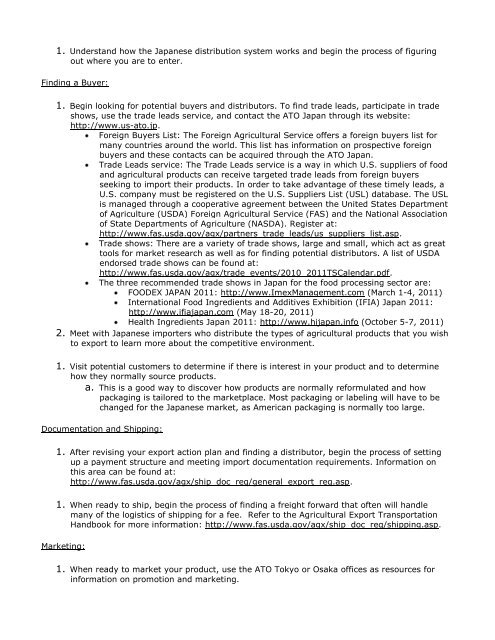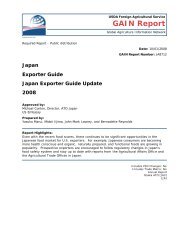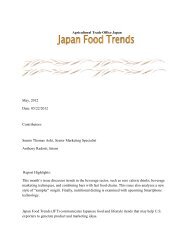Food Processing Sector Food Processing Ingredients Japan
Food Processing Sector Food Processing Ingredients Japan
Food Processing Sector Food Processing Ingredients Japan
You also want an ePaper? Increase the reach of your titles
YUMPU automatically turns print PDFs into web optimized ePapers that Google loves.
1. Understand how the <strong>Japan</strong>ese distribution system works and begin the process of figuring<br />
out where you are to enter.<br />
Finding a Buyer:<br />
1. Begin looking for potential buyers and distributors. To find trade leads, participate in trade<br />
shows, use the trade leads service, and contact the ATO <strong>Japan</strong> through its website:<br />
http://www.us-ato.jp.<br />
Foreign Buyers List: The Foreign Agricultural Service offers a foreign buyers list for<br />
many countries around the world. This list has information on prospective foreign<br />
buyers and these contacts can be acquired through the ATO <strong>Japan</strong>.<br />
Trade Leads service: The Trade Leads service is a way in which U.S. suppliers of food<br />
and agricultural products can receive targeted trade leads from foreign buyers<br />
seeking to import their products. In order to take advantage of these timely leads, a<br />
U.S. company must be registered on the U.S. Suppliers List (USL) database. The USL<br />
is managed through a cooperative agreement between the United States Department<br />
of Agriculture (USDA) Foreign Agricultural Service (FAS) and the National Association<br />
of State Departments of Agriculture (NASDA). Register at:<br />
http://www.fas.usda.gov/agx/partners_trade_leads/us_suppliers_list.asp.<br />
Trade shows: There are a variety of trade shows, large and small, which act as great<br />
tools for market research as well as for finding potential distributors. A list of USDA<br />
endorsed trade shows can be found at:<br />
http://www.fas.usda.gov/agx/trade_events/2010_2011TSCalendar.pdf.<br />
The three recommended trade shows in <strong>Japan</strong> for the food processing sector are:<br />
FOODEX JAPAN 2011: http://www.ImexManagement.com (March 1-4, 2011)<br />
International <strong>Food</strong> <strong>Ingredients</strong> and Additives Exhibition (IFIA) <strong>Japan</strong> 2011:<br />
http://www.ifiajapan.com (May 18-20, 2011)<br />
Health <strong>Ingredients</strong> <strong>Japan</strong> 2011: http://www.hijapan.info (October 5-7, 2011)<br />
2. Meet with <strong>Japan</strong>ese importers who distribute the types of agricultural products that you wish<br />
to export to learn more about the competitive environment.<br />
1. Visit potential customers to determine if there is interest in your product and to determine<br />
how they normally source products.<br />
a. This is a good way to discover how products are normally reformulated and how<br />
packaging is tailored to the marketplace. Most packaging or labeling will have to be<br />
changed for the <strong>Japan</strong>ese market, as American packaging is normally too large.<br />
Documentation and Shipping:<br />
1. After revising your export action plan and finding a distributor, begin the process of setting<br />
up a payment structure and meeting import documentation requirements. Information on<br />
this area can be found at:<br />
http://www.fas.usda.gov/agx/ship_doc_req/general_export_req.asp.<br />
1. When ready to ship, begin the process of finding a freight forward that often will handle<br />
many of the logistics of shipping for a fee. Refer to the Agricultural Export Transportation<br />
Handbook for more information: http://www.fas.usda.gov/agx/ship_doc_req/shipping.asp.<br />
Marketing:<br />
1. When ready to market your product, use the ATO Tokyo or Osaka offices as resources for<br />
information on promotion and marketing.





